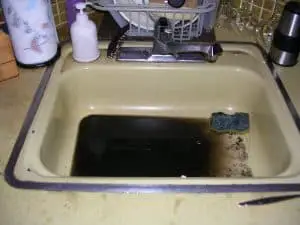Wouldn’t it be great to soak your dishes in the dishwasher as you scrub your pans and bakeware in the sink?
In one of your multitasking runs in the kitchen, you are going to find the need to use these two washing areas at the same.
But, Can You Use the Kitchen Sink While the Dishwasher Is Running?
Yes, but it depends on a few things, including the state of the drain. Remember that the drain is normally shared by the dishwasher, your sink, and even the garbage disposer if you have one installed. Another factor is the pressure of water in the mains. Low water pressure makes it difficult to use any two water outlets at the same time, including your dishwasher and the kitchen sink.
The state of the sink may have a say as well. For example, if the sink is clogged, it will fill up every time you try to use it together with your dishwasher.
Four Reasons Why the Sink May Fill Up If It’s Used Together with A Dishwasher:
There are only two outcomes from using the dishwasher and sink at the time –
- either the sink fills up because of an issue somewhere down the line
- or the water drains smoothly because the line is flawless.
When it becomes impossible to use the dishwasher and the sink at the same time, there must be a problem at one of these five places:
- the sink
- the dishwasher
- the garbage disposal
- the water pressure
- or the air gap:
1. Dishwasher Blockage
You know there’s a probable draining problem with the dishwasher if water stands in your sink when you run the sink but flows smoothly when it turns off.
Stop the dishwasher and the faucet on your kitchen, then check the drain linking your dishwasher to the rest of the line.
If you don’t find an obstruction, the problem may be elsewhere.
If you do, chances are it is a detergent residue that has built with time.
For that reason, you will need to cut on the amount of detergent used in the machine among other measures.
2. Clogged Sink

A clogged sink can make it impossible to use the dishwasher at the same time.
To distinguish this from dishwasher blockage, turn off the dishwasher and try to use the sink – if water fails to move, you can be certain you are dealing with a clogged sink.
Still, if water from the dishwasher backs up into the sink, there’s a strong likelihood your sink is clogged.
Avoid tossing your kitchen wastes down the sink if you don’t have a garbage disposer below it.
Clogged sinks may require a professional to clear, but most situations can be corrected with the user.
Here are a few quick fixes:
- Run your garbage disposal if you have one
- Gently hit or shake the drain without dislodging it from the support
- Use a sink cleaner
3. Air Gap Blockage
Do you have an air gap?
They can be found in kitchen sinks close to the faucet.
The job of the air gap is to separate the hose that links the sink and the dishwasher hence stopping wastewater from flowing back into the dishwasher.
If clogging occurs in the sewer line and you have an air gap installed, the wastewater won’t back into the dishwasher to contaminate your clean dishes.
But how do you identify an air gap-related clog? If the water is flowing back into the sink from your air gap, the gap is certainly clogged.
You can check for blockages by removing the air gap covers and the protective cap to investigate the inside.
If you spot solid wastes, remove them and clean the place to restore them to working conditions.
Call the technician if you can’t access the inner chambers of the air gap.
4. Water pressure
The water used in the dishwasher and the kitchen sink comes from one main line.
Any problem with the mains, including pressure issues, can either cause the used water to back into your kitchen sink or the dishwasher.
Also, if the pressure is too low, you will only be able to use one of these two.
5. Garbage Disposal Plug
Garbage disposals are useful for crushing the solid food wastes poured down the sink (or from the dishwasher) and ejecting them into the sewer line.
If you have one of these devices installed, there’s a good chance it is the source of your kitchen sink plumbing issues.
Most of the garbage disposal unit issues have something to do with its drain plug.
The drain plug covers the opening where your dishwasher or sink drains into your garbage disposal. T
he dishwasher can only drain the right way if you remove this plug immediately after installation.
If you think the plug wasn’t removed and it is responsible for the backing, call the plumber and have it removed.
You need to be careful when correcting dishwasher and garbage disposer problems.
The first step to repairing the problem is to cut the power supply to your dishwasher and garbage disposal.
Water and electricity don’t get along, so you will want to either switch off the power or unplug your appliances directly from your circuit breaker.
Filling The Kitchen Sink While the Dishwasher Is Active
The best method to fill the dishwasher is to start by running the kitchen sink faucet until your water is nice and warm/hot.
This way your dishwasher will fill up with hot washing water rather than cold water.
Dishwashers don’t even hold a lot of hot water at an instant, so running water anywhere else in the home should be absolutely fine.
The conventional energy-efficient dishwasher takes 4 – 6 gallons per cycle compared to average nonenergy-efficient units which use slightly over 6 gallons of water in every cycle.
This is just a fraction of 13 gallons a cycle it was about 15 years.
Another thing is that your dishwasher is designed to make the right adjustments when hot water is running in large amounts in other parts of the house.
This means you can still use it with your kitchen sink regardless of usage elsewhere as long as there are no internal malfunctions.
Bonus Question: Should You Draw Hot Water from The Sink Before Turning On the Dishwasher?
That’s going to depend on several factors as well, more so if it’s in the winter.
During the winter, pipes in homes tend to get cold because they don’t have warming mechanisms installed on them.
For that reason, much of the water you will receive will feel cold even if your water heater is functioning perfectly.
Running hot water for some time will help clear out the cold water from your pipes and then warm it up although it may cause water wastage.
This trick works all the time for both newer and older dishwashers, as the issue stems from your pipes and water heater, not the appliance.
Some dishwashers actually require this trick to work perfectly, like Miele for example.
Lots of other manufacturers recommend it as – they believe – it helps deliver the best results.
Conclusion
But, can you use the kitchen sink while the dishwasher is running?
The answer is “yes” provided the plumbing is trouble-free and both the dishwasher and the sink area are in great working conditions.

